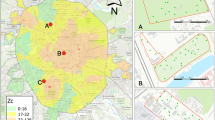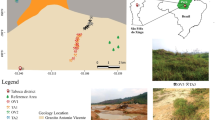Abstract
This study was developed with the aim of determining the activity concentration of 226Ra, 228Ra, 210Pb and 40K in samples of technosols (soils formed by the deposition of tailings from the dam rupture on the banks of rivers and in riverside regions) and in natural soils from the Mariana region in Minas Gerais, after the Mariana tragedy, which is considered the biggest accident in terms of volume of material dumped. The soil samples were analyzed by gamma spectrometry in a hyperpure germanium detector system. The concentrations of all studied radionuclides were higher in the natural soils of Mariana (226Ra 471–1204 Bq kg−1, for 228Ra 415–789 Bq kg−1, for 210Pb 327–641 Bq kg−1 and for 40K 707–2080 Bq kg−1) than in the technosols formed after the accident (226Ra of 179–384 Bq kg−1, for 228Ra of 60–269 Bq kg−1, for 210Pb of 463–818 Bq kg−1 and for 40K of 105–204 Bq kg−1), indicating that the region may present some type of radioactive anomaly or that the use of fertilizers in agricultural soils may have promoted some increase in these elements. On the other hand, the concentrations in the technosols were high when compared with tailings from iron mining in other countries (42 Bq kg−1 for 226Ra and 16 Bq kg−1 for 210Pb), as well as tailings from phosphorus mining in Brazil and in the world. It is admitted that these high values are the result of the mixture of pure tailings with the natural soil of the region, that presented radioactive anomaly, and also result of the peculiar geology of Mina Alegria.









Similar content being viewed by others
References
Adams JAS, Gasparini P (1970) Gamma-ray spectrometry of rocks, methods in geochemistry and geophysics, vol 10. Elsevier, Amsterdam
Alloway BJ (1990) The origins of heavy metals in soils. In: Alloway BJ (ed) Heavy metals in soils. Wiley, New York, pp 29–39
Barros RS (2002) Estimativa de parâmetros ambientais com o suporte do sensoriamento remoto – Estudo de caso: Baía de Guanabara [Estimation of environmental parameters with the support of remote sensing—case study: Guanabara Bay]. Thesis (Masters in Geography)—Universidade Federal do Rio de Janeiro, Rio de Janeiro
Becegato VA, Ferreira FJF, Machado WCP, Cassol PC (2006) Monitoramento ambiental da radioatividade do U, Th e K oriunda de fertilizantes fosfatados em área agrícola no sul do Brasil. Revista de Estudos Ambientais, Blumenau 1:5–19
Bellido AVB (1989) Neutron activation analysis of ancient Egyptian pottery. D.Sc. Thesis. Department of Chemistry, University of Manchester, England, p 324
Bellido AVB, Arezzo BC, Latini RM (1994) Guia de Trabalhos Práticos de Radioquímica. UFF, Departamento de Físico-Química, Niterói
Borges̄ RC, Ribeiro FCA, Lauria DC, Bellido AVB (2013) Radioactive characterization of phosphogypsum from Imbituba, Brazil. J Environ Radioact 126:188–195
Cardoso LX, Souza SO, Ferreira FCL, Ferreira OC, Barboza E, Alnhanati CE (2012) Determination of the specific activity of soil and fertilizers in Sergipe—Brazil. Proc World Acad Sci Eng Technol 80:285–290
Chang BU, Koh SM, Kim YJ, Seo JS, Yoon YY, Row JW, Lee DM (2007) Nationwide survey on the natural radionuclides in industrial raw minerals in South Korea. J Environ Radioact 99:455–460
Coelho LH, Fonseca L, Kaneko KM, Melo JC (1999) A Origem do Fósforo e sua Localização Espacial nos Minérios de Ferro Enriquecidos Supergenicamente. In: II Simpósio Brasileiro de Minério de Ferro: Caracterização, Beneficiamento e Aglomeração. Ouro Preto, pp 44–52
Copper MB (2005) Naturally occurring radioactive materials (NORM) in Australian industries—review of current inventories and future generation. EnviroRad Services Pty. Ltd.
Couto MLF (2009) Caracterização de Alumínio e Fósforo em Minério de Ferro. Thesis (Masters in Mineral Engineering), Universidade Federal de Ouro Preto, UFOP, Minas Gerais
Einax JW, Soldt U (1999) Geostatistical and multivariate statistical methods for the assessment of polluted soils—merits and limitations. Chem Intel Lab Syst 46:79–91
Environmental Systems Research Institute – ESRI (2011) Desktop Help 10.0—How IDW works. Available at: http://help.arcgis.com/en/arcgisdesktop/10.0/help/index.html#/How_IDW_works/009z00000075000000/. Accessed 05 Nov 2019
FAO (2006) Global forest resources assessment 2005. FAO Forestry Paper 147, Rome
Garnar TE (1994) Zirconium and hafnium minerals. In: Carr DD (ed) Industrials minerals and rocks, 6th edn. Society for Mining, Metallurgy, and Exploration, Inc., Littleton, CO, pp 1159–1165
Geoscience Australia (2012). Uranium and Thorium geology. Australian Atlas of Minerals Resources, Mines and Processing Centres
Maia A (2006) Titânio in: Sumário Mineral Brasileiro. DNPM- Departamento Nacional de Produção Mineral, pp 295–299
Malanca A, Pessina V, Dallara G (1993) Assessment of the natural radioactivity in the Brazilian state of Rio Grande do Norte. Health Phys 65(3):298–302
Mayr LM (1998) Avaliação da Baía de Guanabara com o suporte do geoprocessamento [Evaluation of Guanabara Bay with the support of GIS]. Thesis (Doctorate in Geography)—Universidade Federal do Rio de Janeiro, Rio de Janeiro, p 389
Mazzilli BP, Palmiro V, Saueia C, Nisti MB (2000) Radiochemical characterization of Brazilian phosphogypsum. J Environ Radioact 49:113–122
Peixoto CM (2013) Determinação dos valores de referência de qualidade do solo para U e Th no estado de Minas Gerais. Thesis (Doctorate in Nuclear Technology)—Instituto de Pesquisas Energéticas e Nucleares (IPEN), Universidade de São Paulo-SP
Peixoto CM, Fernandes PRM, Rodrigues PCH, Carvalho Filho CA, Feliciano VMD (2016) Distribuição das Concentrações de Atividade de 238U e 232 Th em Amostras de Solo do Estado de Minas Gerais. Braz J Radiat Sci 4:1–18
Peres AC (2007) Modelo para o estabelecimento de valores orientadores para elementos radioativos no solo. 2007. Thesis (Doctorate in Nuclear Technology)—Instituto de Pesquisas Energéticas e Nucleares (IPEN), Universidade de São Paulo-SP
Pires JMM, Lena JC, Machado CC, Pereira RS (2003) Polluting Potencial of Samarco Mineração S.A. Solid Waste: A Germano Dam Case. R Árvore 27:393–397
Piovano EL, Larizzatti FE, Fávaro DIT, Oliveira S, Damatto SR, Mazzilli BP, Ariztegui D (2004) Geochemical response of a closed-lake basin to 20th century recurring droughts/wet intervals in the subtropical Pampean Plains of South America. J Lim 63(1):21–32
Pontedeiro EMBD (2006) Avaliação de Modelos de Impacto Ambiental para deposição de rejeitos sólidos contendo radionuclídeos naturais em instalações minero-insdustriais. Thesis (Masters in Geography)—Universidade Federal do Rio de Janeiro, Rio de Janeiro
Sabedot S, eSampaio CH (2002) Caracterização de zircões da Mina Guaju (PB). Revista Escola de Minas, Ouro Preto- MG, vol 55, no 1. UFOP, pp 49–53
Sillanpaa M (1972) Trace elements in soils and agriculture. Food and Agriculture Organization, vol 17. FAO / SIDA, FAO Soils Bulletin, Rome, 67 p
UNSCEAR—United Nations Scientific Committee on the Effects of Atomic Radiation (2000) Sources and effects of ionization radiation, vol I—sources, report to General Assembly, with Scientific Annexes, United Nations, New York
Varella CAA, de Sena Junior DG (2008) Estudo do Interpolador IDW do Arcview para Utilização em Agricultura de Precisão [Study of IDW Interpolator of Arcview for Use in Precision Agriculture]. http://www.ufrrj.br/institutos/it/deng/varella/Downloads/IT190_principios_em_agricultura_de_precisao/Aulas/estudo%20do%20interpolador%20idw%20arcview.htm. Accessed 11 May 2012
Acknowledgements
The authors would like to acknowledge the Conselho Nacional de Desenvolvimento Científico e Tecnológico (CNPq), Fundação de Amparo à Pesquisa do Estado do Rio de Janeiro (FAPERJ) and Coordenação de Aperfeiçoamento de Pessoal de Nível Superior (CAPES) for the scholarship and financial support. Authors are grateful to Embrapa Solos for authorizing tecnossols sample collecting.
Author information
Authors and Affiliations
Corresponding author
Additional information
Publisher's Note
Springer Nature remains neutral with regard to jurisdictional claims in published maps and institutional affiliations.
Rights and permissions
About this article
Cite this article
Borges, R.C., Mahler, C.F., Gomes, A.C.d. . et al. Radiological characterization of the area impacted by the Mariana dam disaster, in Mariana City-MG-Brazil. Environ Earth Sci 80, 442 (2021). https://doi.org/10.1007/s12665-021-09649-9
Received:
Accepted:
Published:
DOI: https://doi.org/10.1007/s12665-021-09649-9




